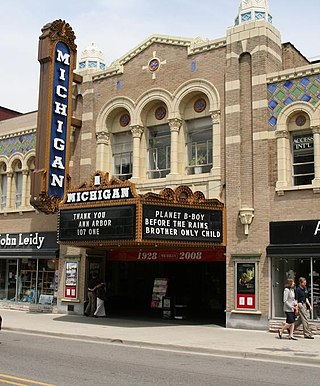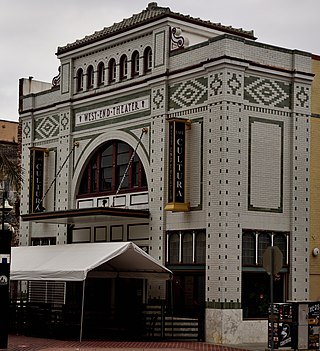
The Tennessee Theatre is a movie palace in downtown Knoxville, Tennessee. The theater was built in 1928 in the 1908 Burwell Building, considered Knoxville's first skyscraper. The theater and Burwell Building were added to the National Register of Historic Places in 1982, and the theater was extensively restored in the early 2000s. The Tennessee Theatre currently focuses on hosting performing arts events and classic films, and is home to the Knoxville Opera and the Knoxville Symphony Orchestra. The theater is managed by AC Entertainment.

The Michigan Theater is a movie palace in Ann Arbor, Michigan, United States, near the Central Campus of the University of Michigan. It shows independent films and stage productions, and hosts musical concerts.

The Midland Theatre is a 3,000-seat theater located in the Power & Light District of Kansas City, Missouri, United States. The National Collegiate Athletic Association under Walter Byers had its headquarters in the building from the 1950s until it moved to 6299 Nall Avenue at Shawnee Mission Parkway in Mission, Kansas in 1971. The theatre was originally known as the Loew's Midland Theatre until 1961. Over the years, the theatre has been known by various names including: Saxon Theatre, Midland Stadium, Midland 1-2-3 Theatre, Midland Theatre and The Midland by AMC, and Arvest Bank Theatre at The Midland.

The Chicago Theatre, originally known as the Balaban and Katz Chicago Theatre, is a landmark theater located on North State Street in the Loop area of Chicago, Illinois. Built in 1921, the Chicago Theatre was the flagship for the Balaban and Katz (B&K) group of theaters run by A. J. Balaban, his brother Barney Balaban and partner Sam Katz. Along with the other B&K theaters, from 1925 to 1945 the Chicago Theatre was a dominant movie theater enterprise. Currently, Madison Square Garden, Inc. owns and operates the Chicago Theatre as a 3600 seat performing arts venue for stage plays, magic shows, comedy, speeches, sporting events and popular music concerts.

Saenger Theatre is an atmospheric theatre in downtown New Orleans, Louisiana, which is on the National Register of Historic Places. Once the flagship of Julian and Abe Saenger's theatre empire, today it is one of only a handful of Saenger movie palaces that remain.

The Redford Theatre is an atmospheric theatre in the Old Redford neighborhood of Detroit. The theatre opened in January 1928, advertised as "Detroit's most unique suburban theatre," due to its grand design, featuring Japanese and Chinese motifs.

The Robert Morton Organ Company was an American producer of theater pipe organs and church organs, located in Van Nuys, California. Robert Morton was the number two volume producer of theatre organs, building approximately half as many organs as the industry leader Wurlitzer. The name Robert Morton was derived not from any person in the company, but rather from the name of company president Harold J. Werner's son, Robert Morton Werner.

Fashion Square Mall is an enclosed shopping mall located in the northern edge of Saginaw Charter Township, Michigan. It lies within the boundaries of M-84 to the west, Tittabawassee Road to the north, Fashion Square Blvd. to the east, and Schust Road to the south. The mall serves the city of Saginaw, its suburbs, and the greater Great Lakes Bay Region. It features more than 100 tenants, including a food court, and its anchor stores are JCPenney and Macy's.
The Capitol Theatre is a theatre operating in Rome, New York. It opened December 10, 1928 as part of the Kallet chain of movie houses, presenting first run films until it closed in 1974. After extensive renovation, the theatre re-opened in 1985 as the non-profit Capitol Civic Center, offering classic films, live theatrical performances, and concerts.

The State Theatre is a movie palace in Ann Arbor, Michigan, designed by C. Howard Crane in the Art Deco style.

The State Theatre was a single-screen movie theater located in Bay City, Michigan. Built in 1908 during the booming lumbering era in Michigan, the State Theatre was originally known as the Bijou, and was one of the many vaudeville and burlesque houses in Bay City. In 1930 the theater was renovated and reopened as the "Bay."

The Virginia Theatre is a live performance and movie theatre in downtown Champaign, Illinois. It has been providing theatrical and cinematic entertainment to the Champaign-Urbana community since its doors opened in 1921. Each year, the Virginia Theatre is host to movies from film reels, plays from various acting troupes, concerts, and Ebertfest, presented by the UIUC College of Media. It is currently owned by the Champaign Park District.

The Oriental Theatre was a movie theater located at 828 SE Grand Street in the East Portland commercial district of Portland, Oregon that was built in 1927. The Oriental was a 2,038-seat movie palace designed by Lee Arden Thomas and Albert Mercier. The building's exterior was in the Italian Renaissance style. The interior had an "almost surreal appearance" created by interior designer Adrien Voisin. It was built by George Warren Weatherly. Demolished in 1970, the theater was adjacent to the Weatherly Building, which remains standing.

The Capitol Theatre Building is a cinema and concert venue located at 140 E. 2nd St. in Flint, Michigan. Designed by John Eberson, it is an atmospheric theater designed to look like a Roman garden. The Capitol Theatre opened in 1928, and operated as a cinema and live performance venue until 1996. The theatre was listed on the National Register of Historic Places in 1985.

The State Theatre is a Spanish-styled atmospheric theatre in Kalamazoo, Michigan, designed by renowned architect John Eberson. The State was built for W.S. Butterfield Theatres in 1927, and remains in operation today, presenting live shows. The theatre was listed on the National Register of Historic Places in 2021.
W. S. Butterfield Theatres, Inc. was an operator of vaudeville theaters and later movie theaters in the Lower Peninsula of Michigan. Beginning in the early 1900s, "Colonel" Walter Scott Butterfield expanded his business from one vaudeville house in Battle Creek in 1906 to 114 cinemas across Michigan in 1942. The Butterfield circuit was reduced to 21 theaters by 1984, when it was sold to George Kerasotes.

The Maltz Opera House is a theater in Alpena, Michigan, named after Alpena banker George L. Maltz. The Maltz is currently under restoration to its 1930s-era appearance, and is expected to be listed on the National Register of Historic Places.

The Martha Washington Theatre is a former movie theater in Ypsilanti, Michigan. The Martha Washington was built and initially operated by Florence W. Signor of Ypsilanti, the only woman theatre operator in Michigan at the time. Signor sold the Martha Washington to W. S. Butterfield Theatres in 1925, which operated it as a first-run cinema until the 1970s.

The California Theatre is a historic theatre in Old Town Pittsburg, Callifornia.

The West End Theater is a historic former movie theater on 4th Street in Santa Ana, California. Developer L. A. Schlesinger commissioned the theater in 1915 and architect James Flood Walker designed the building. It was later operated by Santa Ana theater proprietor C. E. Walker and named the State Theater. It showed arthouse and foreign film in the 1960s as the Guild Theater and was operated as an adult movie theater called the State Arts Theater in the 1970s. After the venue closed in 1978, the building survived a series of demolitions downtown. It has since been repurposed as a cafe.





















